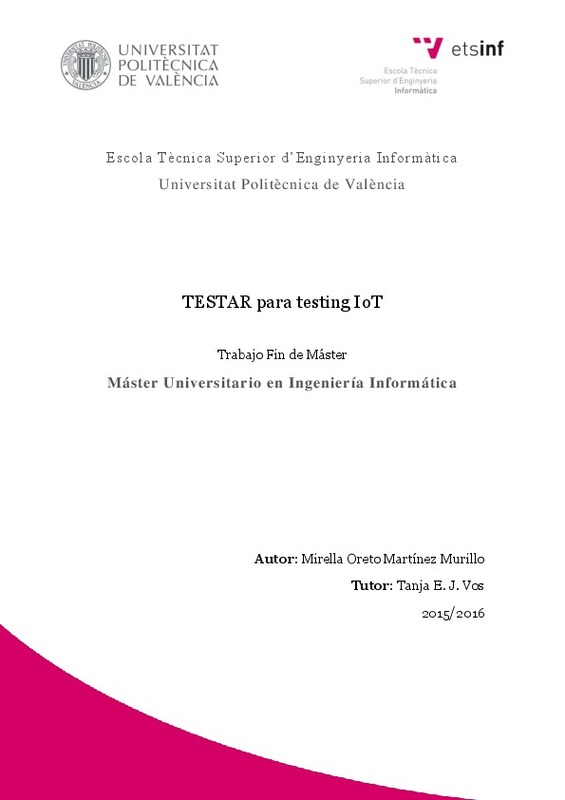JavaScript is disabled for your browser. Some features of this site may not work without it.
Buscar en RiuNet
Listar
Mi cuenta
Estadísticas
Ayuda RiuNet
Admin. UPV
TESTAR para testing IoT
Mostrar el registro sencillo del ítem
Ficheros en el ítem
| dc.contributor.advisor | Vos, Tanja Ernestina
|
es_ES |
| dc.contributor.author | Martínez Murillo, Mirella Oreto
|
es_ES |
| dc.date.accessioned | 2016-10-13T07:31:31Z | |
| dc.date.available | 2016-10-13T07:31:31Z | |
| dc.date.created | 2016-09-26 | |
| dc.date.issued | 2016-10-13 | es_ES |
| dc.identifier.uri | http://hdl.handle.net/10251/71683 | |
| dc.description.abstract | [ES] El número de dispositivos conectados a internet ha aumentado en los últimos años. Con ello, la llamada Internet de las Cosas (IoT, por sus siglas en inglés) se está convirtiendo en una realidad. Se trata, por tanto, de un tema que dispone del potencial necesario para cambiar el modo en el que las personas vivimos e incluso trabajamos. Para poder aprovechar las ventajas que la IoT puede aportarnos es necesario asegurar la calidad de los dispositivos masivamente interconectados. Aplicar testeo automático se presenta como un medio para satisfacer dichas necesidades. Sin embargo, conlleva varias dificultades como la falta de estándares y las limitaciones en recursos como batería y memoria. En este trabajo se parte de una herramienta de testeo automático a nivel de interfaz de usuario que ha sido aplicada con éxito en diversos entornos industriales. A partir de ella, se desarrolla una nueva aplicación que, manteniendo su filosofía y aproximación, es aplicable al mundo de la IoT. La herramienta desarrollada es evaluada mediante el testeo de una vivienda inteligente y se presentan los resultados obtenidos. | es_ES |
| dc.description.abstract | [EN] As the number of devices connected to the Internet is increasing, the so-called Internet of Things (IoT) is becoming a reality. It even has the required potential to change both the way we live and the way we work. In order to take advantage of the benefits that the IoT can bring us, ensuring the quality of massively interconnected devices becomes a pressing necessity. A means of satisfying this need would be automated testing of IoT devices. However, this presents many difficulties such as the lack of standards and limitations in battery and memory. In this work we start from an automated testing tool at the user interface level that has already been successfully applied in several industrial cases. Maintaining its philosophy and approach, a new tool is developed which is applicable to the IoT environment. The tool is evaluated by testing a smart home and the results are presented. | es_ES |
| dc.format.extent | 82 | es_ES |
| dc.language | Español | es_ES |
| dc.publisher | Universitat Politècnica de València | es_ES |
| dc.rights | Reconocimiento (by) | es_ES |
| dc.subject | Internet de las cosas | es_ES |
| dc.subject | IoT | es_ES |
| dc.subject | Testeo automático | es_ES |
| dc.subject | Vivienda inteligente | es_ES |
| dc.subject | Internet of Things | es_ES |
| dc.subject | Automated testing | es_ES |
| dc.subject | Smart home | es_ES |
| dc.subject.classification | LENGUAJES Y SISTEMAS INFORMATICOS | es_ES |
| dc.subject.other | Máster Universitario en Ingeniería Informática-Màster Universitari en Enginyeria Informàtica | es_ES |
| dc.title | TESTAR para testing IoT | es_ES |
| dc.type | Tesis de máster | es_ES |
| dc.rights.accessRights | Abierto | es_ES |
| dc.contributor.affiliation | Universitat Politècnica de València. Departamento de Sistemas Informáticos y Computación - Departament de Sistemes Informàtics i Computació | es_ES |
| dc.contributor.affiliation | Universitat Politècnica de València. Escola Tècnica Superior d'Enginyeria Informàtica | es_ES |
| dc.description.bibliographicCitation | Martínez Murillo, MO. (2016). TESTAR para testing IoT. http://hdl.handle.net/10251/71683. | es_ES |
| dc.description.accrualMethod | TFGM | es_ES |
| dc.relation.pasarela | TFGM\42462 | es_ES |
Este ítem aparece en la(s) siguiente(s) colección(ones)
-
ETSINF - Trabajos académicos [5160]
Escola Tècnica Superior d'Enginyeria Informàtica






